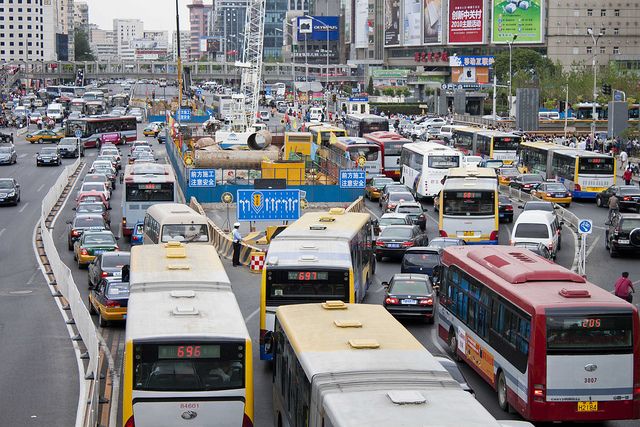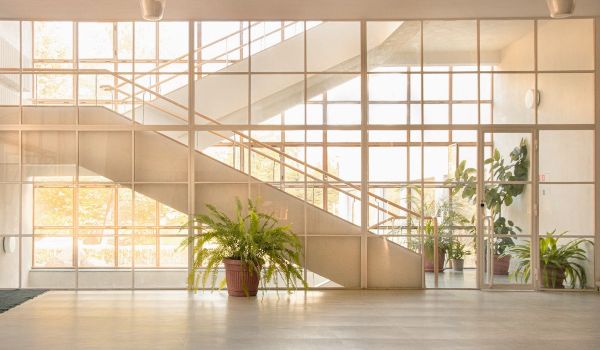This piece originally ran on The City Fix.
In February 2012, the number of cars in Beijing exceeded 5 million. Given the problematic levels of traffic congestion and air pollution in the Chinese capital, few people hailed the milestone as an “achievement.” Car ownership rose to this level 11 months later than originally predicted, thanks to a city policy that issues license plates based on a monthly lottery system.
Traffic conditions in Beijing have been sending residents constant surprises by becoming even worse than thought to be the worst. According to IBM’s Commuter Pain Study, Beijing topped the list for the most painful commute in the world. Frequent gridlocks are turning Beijing’s modern ring roads into a vast open parking garage. The average time Beijing-ers spend on commuting is 43 minutes—the longest among Chinese cities.
Accompanying the pain of commuting is the pain of breathing polluted air, which anyone living in the city cannot avoid. Last year, high readings of PM 2.5 (particulate matter smaller than 2.5 micrometers in diameter that causes respiratory and cardiovascular diseases) by the U.S. Embassy in Beijing created great public unease and serious health concerns. Beijing—the power center of China—was sadly referred to as being “unlivable,” with PM 2.5 levels sometimes six times higher than the daily limit recommended by the World Health Organization.
The Beijing government is—or at least seems to be—taking progressive actions to address congestion and air pollution. At the institutional level, the Beijing municipal government lists curbing fine particle pollution as its top priority for 2012, ahead of housing, health and education. Facing great public pressure, the government began measuring PM 2.5 on January 21, right before the Chinese New Year (previously, there were only readings from the U.S. Embassy.) The city vows to slash PM 2.5 pollution by nearly 30 percent by 2020.
While making information transparent is a great first step, the government needs to take more aggressive measures.
Demand control is a prime strategy
Other than the license plate lottery system, Beijing has traffic restrictions on private vehicles, based on the last digit number of license plates, which keeps one-fifth of its vehicles off the road on weekdays. To show its resolution to battle air pollution, the Beijing government would also reduce the usage of official vehicles, very likely through forcing official vehicles to comply with the restriction. The number-based traffic restriction, started after the Olympics, has just been renewed again. It will continue to be valid through this year.
Meanwhile, the city of Beijing is among the major cities that plan to issue congestion charging at rush hour, with the aim of curbing vehicle use.
Enforcing vehicle emission standards
Last month, Beijing announced that it will implement a stricter vehicle emission regulation this year, ahead of other provinces in China. The national five-vehicle emission standard, which Beijing is going to adopt, is equivalent to the Euro 5 emission standard applied to passenger and light vehicles. Beijing’s vehicle emission standard would likely be tightened again by 2016 to meet the Euro 6 emission standard.
Meanwhile, Beijing’s traffic agency launched a campaign targeting large trucks. Cargo trucks that fail to meet gas emission standards at checkpoints are not allowed to enter the capital.
What else? Electric vehicles?
To promote the use of renewable energy vehicles, Beijing opened China’s largest electric car charging station in January. This station, located in Chaoyang District, is “installed with more than 10 types of EV charging or battery swapping machines, covering all charging modes that are available in China,” according to Xinhua. Beijing is one of the 25 pilot cities for implementing new energy vehicles.
Long way to go
It seems that the Beijing government is taking almost every possible measure to make people drive less and emit fewer pollutants to save the Chinese capital. But with automobile sales as a key driver for the Chinese economy, it is unlikely that the government will take aggressive nationwide actions against it or its related industries. For example, it quietly shelved national diesel emission standards in February, which is believed to be related to the economic interests of national petrol companies. EV cars, which the Chinese government invests heavily, might be a solution, yet there is still doubt about whether EV cars in China are really “clean.” A recent study shows that EVs might be more harmful than gasoline-based vehicles, since coal is so widely used for power generation in China.
Air quality seems to be a bit better after the launch of PM 2.5 monitoring, though hazy days haunt the city occasionally. Fuel prices are skyrocketing, but hundreds of thousands of people in Beijing are persistently trying their luck in the monthly car license plate lottery, hoping to legally own a private car and drive on the already congested streets. Meanwhile, rapid metro construction is moving quickly. The Beijing government has put huge efforts on upgrading public transit and promoting non-motorized modes, which could be the right direction to go.
















